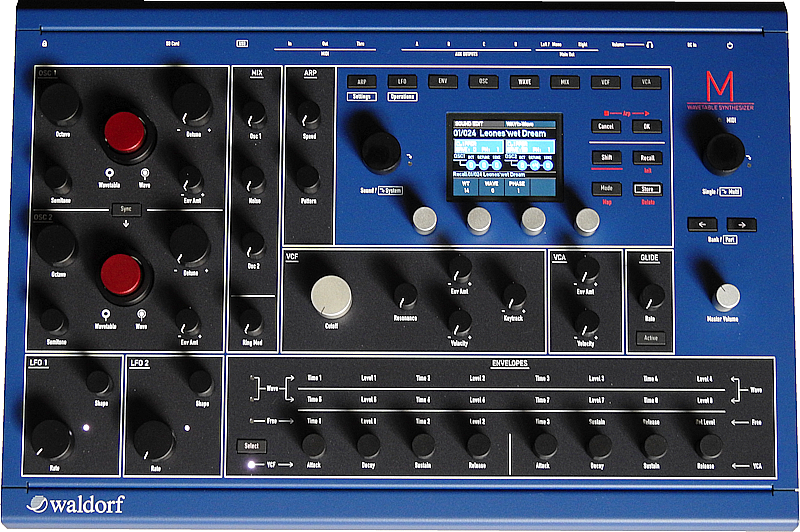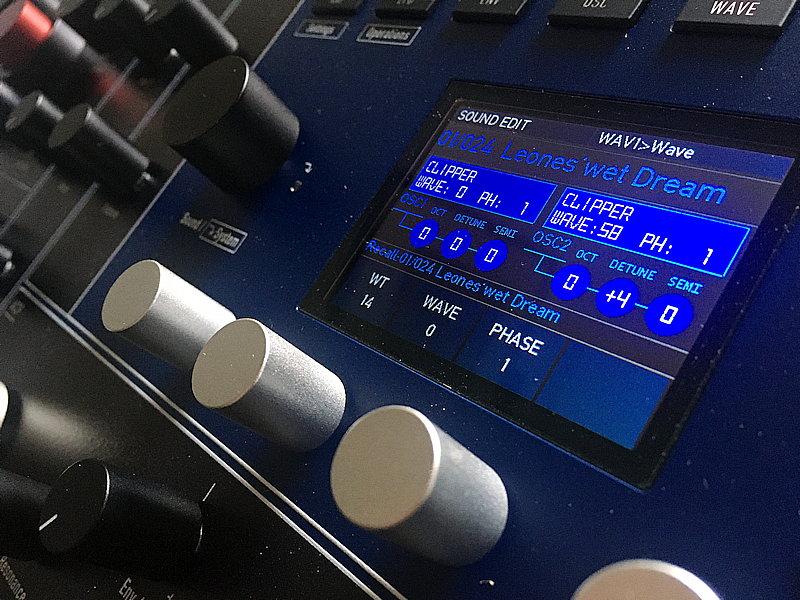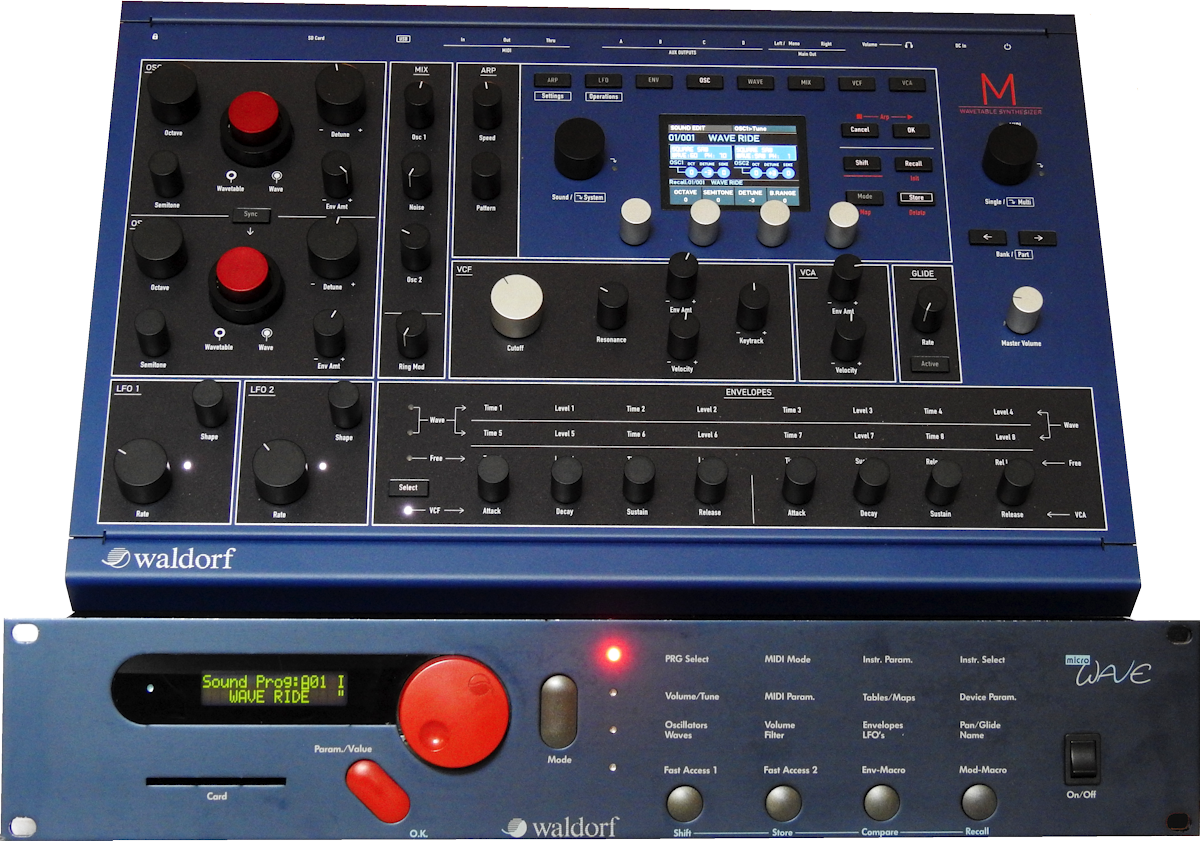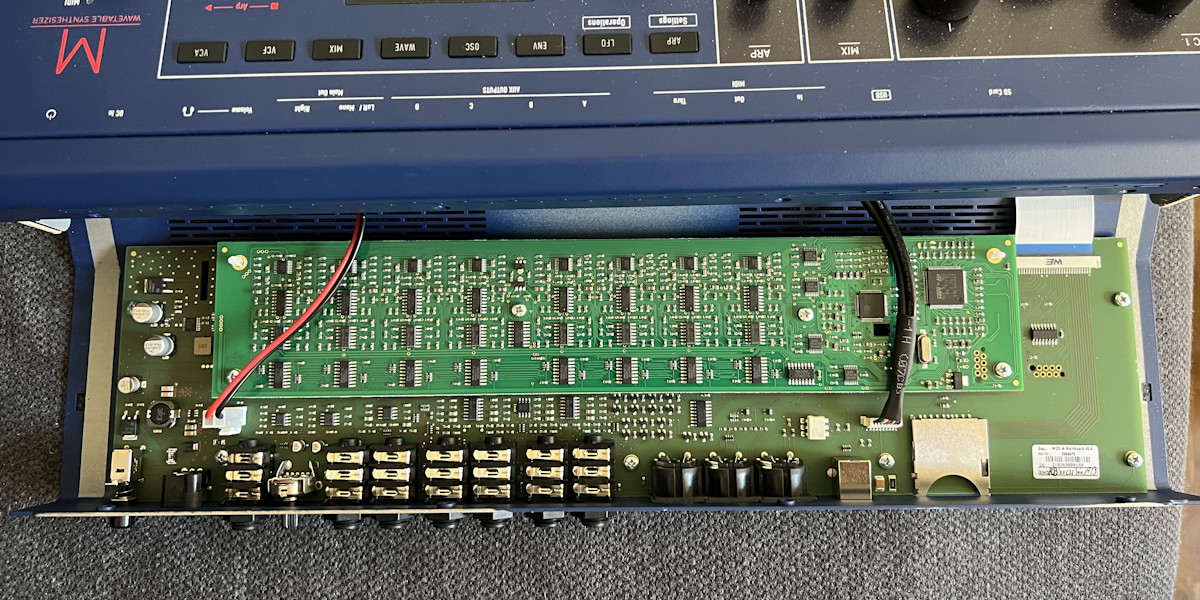Waldorf M

Die Wiedergeburt eines Klassikers
Der Waldorf M klingt fast wie der original microWave, Die Oszillatoren habe definitiv den richtigen Klang. Die microWave II/XT(k) Oszillatoren klangen einfach anders. Deshalb kann man auch auf deren Klang umschalten. Aber es fehlen für einen echten microWave II Nachfolger die besonderen Modulationsmöglichkeiten und die digitalen Filtermodelle. Der hier im M an Stelle des Curtis Filters CEM 3389 (Rev. A) bzw. CEM 3387 (Rev. B) verwendete Nachbau des SSM Filters 2044 mit der Bezeichnung SSI 2144 ergibt einen noch mehr in Richtung PPG wave 2.2/3 gehenden Klangcharakter. Insbesondere, wenn die Filterresonanz aufgedreht wird.
Wegen dem anderen Filter ist ganz klar, dass man hier keinen original microWave mit mehr Drehknöpfen nachbauen wollte, sondern eine moderne Interpretation eines microWave mit dessen besonderen Oszillatoren erreichen wollte. Und das ist definitiv geglückt.
Der Import von Wellensätzen als 8 Bit, unsigned raw audio mit 256 Sample-Worten pro Wellenform funktioniert gut. Das in der Anleitung "signed" steht, ist leider ein Fehler.
The reincarnation of a classic
The Waldorf M sounds nearly like the original microWave. The oscillators got for sure the right sound. The microWave II/XT(k) oscillators sounded different. Because of this, you can also switch to their sound. But missing towards a real microWave II successor are the special modulation possibilities and the digital filter modes. The here in the M in stead of the Curtis filter CEM 3389 (Rev. A) bzw. CEM 3387 (Rev. B) used clone of the SSM Filters 2044 named SSI 2144 gives a more into PPG wave 2.2/3 sounding character. Especially if the filter resonance is turned up.
Because of the different filter it is quite obvious, that they did not try to rebuild a new original microWave with more knobs, but they aimed a modern interpretation of a microWave with its special oscillators. And they reached the goal for sure.
The importing of wavetables as 8 bit, unsigned raw audio with 256 sample words per wave cycle is working well. And the 2signed" written in the manual is just a mistake.


Waldorf M auf Waldorf microWave / Waldorf M atop Waldorf microWave
| 1 RESONANT | 49 KARPSTRONG 2 |
| 2 RESONANT2 LP | 50 KARPSTRONG 3 |
| 3 MALLET SYNTH | 51 1-2-3-4-5 |
| 4 SQUARE SWEEP | 52 NINETEEN/TWENTY |
| 5 BELL | 53 WAVETRIP 1 |
| 6 PULSE SWEEP | 54 WAVETRIP 2 |
| 7 SAW SWEEP | 55 WAVETRIP 3 |
| 8 MELLOW SAW | 56 WAVETRIP 4 |
| 9 FEEDBACK | 57 MALE VOICE |
| 10 ADD HARM | 58 LOW PIANO |
| 11 RESONANT3 HP | 59 RESONANT SWEEP |
| 12 WIND SYNTH | 60 XMAS BELL |
| 13 HIGH HARM | 61 FM PIANO |
| 14 CLIPPER | 62 FAT ORGAN |
| 15 ORGAN SYNTH | 63 VIBES |
| 16 SQUARE SAW | 64 CHORUS 2 |
| 17 FORMANT 1 | 65 TRUE PWM |
| 18 POLATED | 66 WAVE2.3 SAWSYNC |
| 19 TRANSIENT | 67 WAVE2.3 UPWAVES |
| 20 ELEC PIANO | 68 Q ALT 1 |
| 21 ROBOTIC | 69 Q ALT 2 |
| 22 STRONG HARM | 70 WAVE2.2 CLIPPER |
| 23 PERC ORGAN | 71 WAVE2.2 PSAX |
| 24 CLIP'N'SWEEP | 72 WAVE2.3 PSAX |
| 25 RESO HARM | 73 MAYSCHLOSS WINE |
| 26 2 ECHOES | 74 PARKS OF BONN |
| 27 FORMANT 2 | 75 NIEDERZISSEN |
| 28 FORMANT VOC | 76 KRIPPER FERRY |
| 29 MICRO SYNC | 77 SINZIGER ORGAN |
| 30 MICRO PWM | 78 LA PALMA'S SUN |
| 31 GLASSY | 79 REMAGEN WORKS |
| 32 SQUARE HP | 80 AHRTAL WALKS |
| 33 SAW SYNC 1 | 81 3V MULTI AAH |
| 34 SAW SYNC 2 | 82 3V CLARINET |
| 35 SAW SYNC 3 | 83 3V CONCERT G-TAR |
| 36 PULSE SYNC 1 | 84 3V CELESTE |
| 37 PULSE SYNC 2 | 85 3V MARIMBA |
| 38 PULSE SYNC 3 | 86 3V BELL |
| 39 SINE SYNC 1 | 87 3V GRAND PIANO |
| 40 SINE SYNC 2 | 88 3V ELPIANO |
| 41 SINE SYNC 3 | 89 3V TROMBONE |
| 42 PWM PULSE | 90 3V PLUCK BASS |
| 43 PWM SAW | 91 3V GL BASS |
| 44 FUZZ WAVE | 92 3V HARP |
| 45 DISTORTED | 93 3V SITAR |
| 46 HEAVY FUZZ | 94 3V ELGITAR TTR |
| 47 FUZZ SYNC | 95 3V V-SYNTH |
| 48 KARPSTRONG 1 | 96 3V HAUSORGAN |
Die Wellensätze 1 bis 28 stammen ursprünglich vom den PPG waves. 29-65 wurden erstmals im microWave OS 2.0 eröffentlicht. Die mit "WAVE2.2" bzw. "WAVE2.3" beginnenden stammen von den entsprechenden PPG waves. Die mit "3V" beginnenden stammen vom Waldorf wave 3.V Softsynth. Alle anderen sind neue mit überwiegend auf Orte in der Nähe vom Waldorf Firmensitz sich beziehende Namen.
The wavetables 1 to 28 origin from the PPG waves. 29-65 were released with the microWave OS 2.0. The ones starting with "WAVE2.2" or "WAVE2.3" origin from the PPG waves. The ones starting with "3V" origin from the the Waldorf wave 3.V soft synth. All others are new ones. They got nearly all names relating to local places near the Waldorf company.
Innenleben / Inside

Vorne die Rückseite des Panels. Zwei rote Steckverbinder für die zukünftige Stimmenerweiterung
The backside of the panel PCB in the front Two red connectors for the upcoming voice expansion

Die analogen Chips einer Stimme:
Oben der Filterchip SSI 2144. Dadrunter der vierfach VCA SSI 2164 Chip. Der TL074C Chip dadrunter ist ein Low Noise J-FET Quad OP-Amp.
The analog voice chips
On top the SSI 2144 filter chip. Below the quad VCA SSI 2164 chip. The TL074C chip below is a Low Noise J-FET Quad OP-Amp.

Das Gehirn
Ein STM32F765VGT6 ARM® Cortex®-M7 CPU mit 1 MB Flash-Speicher und ein Cirrus Logic CS42888 (4 24-bit A/D und 8 24-bit D/A Wandler)
The brain
A STM32F765VGT6 ARM® Cortex®-M7 CPU with 1 MB of flash memory and a Cirrus Logic CS42888 (4 24-bit A/D and 8 24-bit D/A converters)

Eingebaute Stimmenerweiterung (dann 16 Stimmen)
Installed voice expansion.